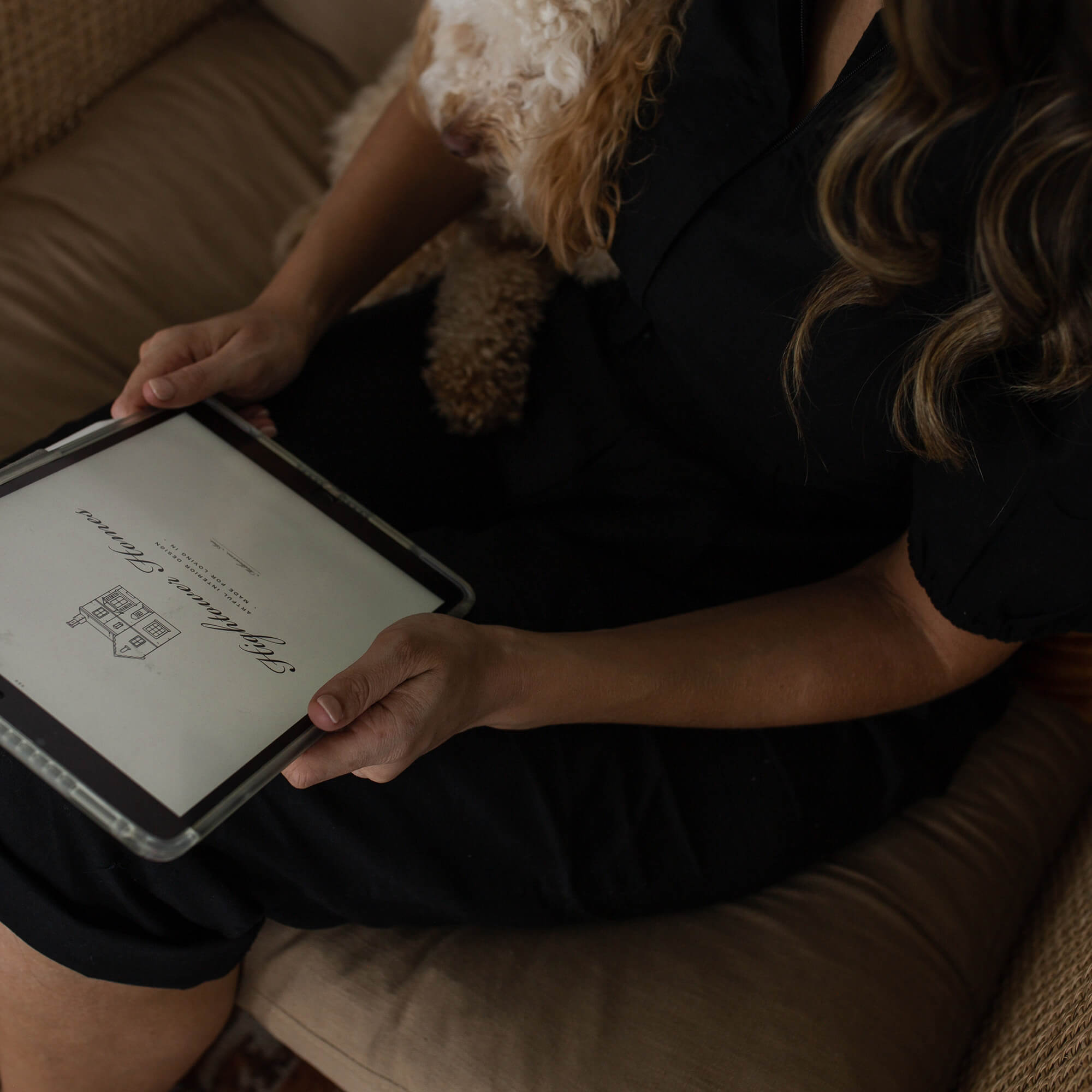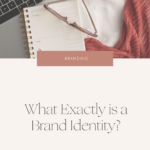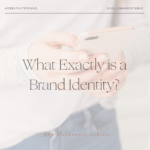If you’ve ever been confused by the term “brand identity”, this one’s for you.
Between “branding”, “brand voice”, “brand identity”, “visual identity” and the overarching term “brand”, there’s a lot happening under that umbrella. These terms are sometimes used interchangeably but, in reality, they all have their own meaning.
Brand identity is an essential part of the design process here at Hello Magic Studio so, in this post, we’ll clear it up.
Clients occasionally ask us if they can skip the Brand Identity package and go straight into website design. While, technically, you could throw together web pages without working on an identity, you’d be losing out on the most important benefits of design.
No matter what you do, your brand will have an identity because it’s impossible to avoid portraying a visual feeling through a website. Even if you decided to put up a random, unformatted black and white website, it would still have an “identity”.
The issue with this is, if you’re not intentional with your brand identity, you won’t attract the right people. Or, even worse, you won’t attract anyone.
As humans, our sense of identity is critical to feeling fulfilled and driven. It’s no wonder we fear a “loss of identity”. When a person has an identity crisis, they question their sense of self and purpose, which can lead to a serious case of the blues.
We won’t say brands are the same as living, breathing human beings. However, like people, identity is a crucial part of your business too. When there’s confusion around that identity, your brand can fall apart or fail to flourish.
What is a “brand”?
First, to understand “brand identity”, we need to define “brand”. We all “know” what a brand is, but…do we? It’s one of those concepts that we’re constantly exposed to, yet it’s tricky to define.
This definition by American author Seth Godin is hard to beat:
“A brand is the set of expectations, memories, stories and relationships that, taken together, account for a consumer’s decision to choose one product or service over another.”
A brand is everything from the business’s personality and values, to the packaging, price point, customer service, design, and beyond. It’s the whole experience created by a business to help it stand out from competitors and create a memorable impression on customers. Brand identity is an essential part of creating that experience.
A “business” or “company” is a corporate entity that people don’t feel immediate feelings for. A brand triggers emotions and creates a desire to be associated with that identity because it resonates with the consumer in some way.
Take Coca Cola. You probably don’t feel warm and fuzzy inside thinking about the big CEOs and their billion-dollar marketing strategies. But many people around the world do feel an emotional connection to Coke (the Pepsi vs. Coke debate is a thing for a reason).
Whether you’re a big soda drinker or not, you probably associate the Coca Cola brand with something that brings friends and families together. You might think of days spent exploring with pals or of a cosy nostalgia for holiday festivities (cue the polar bears and Santa Claus sipping glass bottles). That’s the power of an effective brand identity. It turns the impersonal “business” into a relatable, attractive “brand”.
What is a “brand identity”?
Put simply, a brand identity is the collection of elements your business portrays to its consumer. When combined, these elements create an impression on your prospects.
You can consider brand identity in two pillars: internal and external.
Internal brand identity, sometimes called “brand strategy”, is the non-visual stuff. It’s your brand values, mission, voice, and positioning. What drives your business? Are you setting to solve core problems? Do you want to give off a certain tone in your messaging? What is unique about your offerings?
The brand’s external identity (or visual identity) is where graphic design comes in. It’s so much more than a logo and a colour palette. It’s how all of the visual elements of your brand reflect and align with the internal identity.
Once you develop a brand identity, it must be consistent. That means it has to be recognisable across all parts of your website and in collateral materials like business cards, social media visuals, physical product packaging, and beyond. Consistency builds trust with your customers. If your brand identity is inconsistent, it comes off as less authentic and less professional.
Check out some of the brand identities we’ve created on Pinterest.
Elements of a brand identity
Composed of many pieces, your visual brand identity must seamlessly work together. It can include a primary logo, secondary logo, colour palette, font system, brand mark(s), patterns, textures, slogans, imagery. Depending on the brand, we can also look at elements like illustrations, iconography, and website animation.
Let’s break down a few of these elements:
Logos
Everyone knows logos are a major part of branding. Logos have to communicate your values as a business in a visually appealing way that makes a lasting impression on your target audience. You need multiple formats of your logo (different colour variations and sizes) to ensure the logo is versatile enough to work with the rest of the brand identity in every context.
Colours
Colour palettes have the ability to make or break a brand identity. Everyone—your prospects included—has psychological ties to different colours. These subconscious feelings about certain colours are further amplified when they’re part of a palette. With so many gorgeous colours out there, it can be tempting to try them all out or choose our personal favourites. But we must be strong! Brand identity colours palettes must be chosen strategically and thoughtfully.
Typography
Typography may seem like a minor detail but it plays a pivotal role in every brand identity. There are thousands of typefaces and fonts which can all be classified in different ways, such as technical style (serif, sans serif, script, display, etc) or mood (formal vs. informal, modern vs classic/traditional, and light vs dramatic). Like colours, typography and fonts all portray their own feelings and appeal to different audiences. It’s important for them to work well with the logo but also hold up the brand identity on their own. Each brand identity uses at least two or three typefaces that must complement each other.
Imagery
Images evoke emotions in a powerful way. Seemingly simple things like framing, lighting, and angle can completely change the mood set by an image. If the images on your website and other digital platforms don’t align with the rest of your brand identity, they will confuse your audience and drag down the overall effectiveness of the brand. A strong visual identity provides creative direction to ensure the photography works with the rest of the design.
Texture and Pattern
Textures and patterns are elements of visual brand identity that are often overlooked. Yet, they’re one of our favourite ways to portray the feeling behind a brand. Whether it’s a luxe metallic gold texture, a rustic brick-like texture, a hand-painted background or a subtle feminine pattern, they can play into a brand identity in a surprisingly strong way.
Our Process
Creating a brand identity is a central part of our process at Hello Magic Studio. The first step is Brand Strategy. Successful design is rooted in this strategy with your audience firmly at the centre, so we start by analyzing your business to develop an authentic identity from the ground up. You receive an in-depth brand strategy document that outlines your brand’s ethos, audience, competition, and overall goals.
After diving deep into your brand’s strategy, we craft your visual identity using the One Concept Method. Using a collaborative approach, we make sure every last detail is thoughtfully crafted to attract the right people to your business like a magnet.
If you purchase copywriting services, we also write your website copy based on your brand strategy and identity to ensure the words on your website are thoroughly aligned with your visual brand.
Finally, we bring it all to life through your website and collateral items.
By the end of working together, you have a thoughtfully developed full brand identity to compete fiercely in the market and bring in your dreamiest customers.
Ready to find your identity?
Our passion lies in branding and establishing a strong foundation for businesses to grow from, starting with brand identity. Click here to learn more about our process.
If you have questions, we’d love to hear from you in the Instagram DMs!
At Hello Magic, we are in love with Showit. We’re all about building beautiful websites that attract your dream customers and the only thing better than a gorgeous online home is a gorgeous online home that converts. To get the best of both worlds, you need to know how to optimise your Showit site for SEO.

Excellent photography is one of the key ingredients in a show-stopping, stand-out-from-the-crowd kind of website. Here are our top tips for planning a brand photoshoot that will produce website-worthy images.

“Should I use Showit or Squarespace for my website?” This is a question we hear from many clients. And no wonder. Figuring out whether you should create a website using Squarespace or Showit is like trying to find a consensus over whether pineapple belongs on pizza or not.

Are you considering investing in professional branding or a rebranding project but unsure if it’s even worth it? It’s a valid concern. After all, there are many factors to take into account when making such an important decision for your business. To help you out, we’ll share with you a few cold, hard stats about the benefits of branding that just might convince you to take the plunge.

Template or custom: which is right for you? In this post, we compare all the differences between a custom Showit design and a Showit premade template to figure out which option is best for you and your business.

At Hello Magic, we are in love with Showit. We’re all about building beautiful websites that attract your dream customers and the only thing better than a gorgeous online home is a gorgeous online home that converts. To get the best of both worlds, you need to know how to optimise your Showit site for SEO.

Are you considering investing in professional branding or a rebranding project but unsure if it’s even worth it? It’s a valid concern. After all, there are many factors to take into account when making such an important decision for your business. To help you out, we’ll share with you a few cold, hard stats about the benefits of branding that just might convince you to take the plunge.






